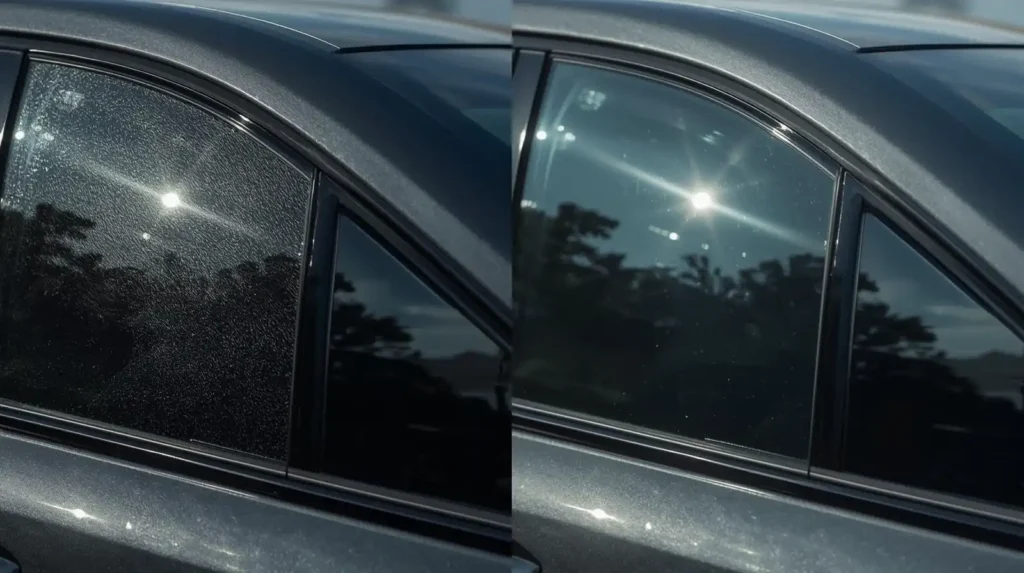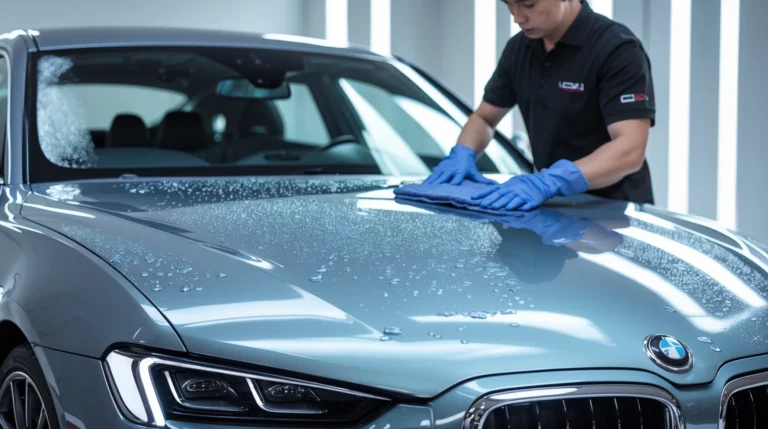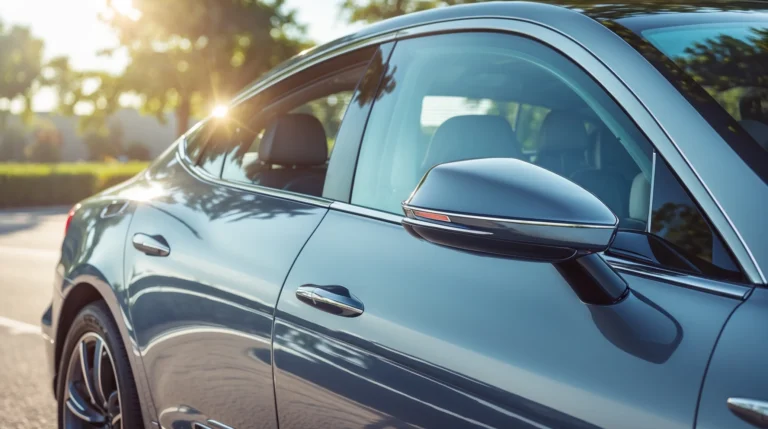When choosing window tint for your car, two types often stand out: nano ceramic tint vs carbon tint Both improve comfort, reduce glare, and protect your car from harmful UV rays. But they work differently and perform at different levels. This guide explains the differences between them how they block heat, affect visibility, and protect your car’s interior so you can make a smart choice that fits your lifestyle and budget.
Understanding Modern Window Tinting Technologies
Window tinting has come a long way from simple dark films used just for privacy. Today’s tints are made with advanced materials that do far more than make your car look stylish. Modern carbon window tinting and nano ceramic tint films are designed to protect you from harmful sun rays, reduce heat, and improve driving comfort all year round.
Tint technology now focuses on performance, not just looks. By using microscopic particles or carbon layers, these tints reject infrared radiation the part of sunlight that makes your car hot. They also block ultraviolet (UV) rays, which cause fading and skin damage.
High-quality window tints like these can even improve safety by holding shattered glass together during accidents. Whether you choose carbon tint or ceramic tint, the goal is the same: a cooler, safer, and more comfortable drive.
What Makes Nano Ceramic Tint and Carbon Tint Different?
At first glance, nano ceramic tint vs carbon tint might seem similar. Both offer protection against sunlight and add a sleek finish to your car. The real difference lies in what they’re made of and how they perform.
- Carbon tint uses carbon particles embedded in the film. These particles reduce heat and prevent fading. They’re known for durability and rich color tone.
- Nano ceramic tint is made using non-metallic, non-conductive ceramic nanoparticles. These particles block heat and UV rays more effectively without affecting signal transmission.
While both reduce glare and keep interiors cool, ceramic window tint vs carbon comes down to performance level. Ceramic tints provide superior heat rejection and clarity, making them a premium choice for car owners who value top performance and long-term results.
What Is Carbon Tint and How Does It Work?

Carbon tint is one of the most popular mid-range tint options for cars. It gets its name from the carbon particles infused into the film during manufacturing. Unlike older dyed films, carbon tint film doesn’t fade or turn purple over time.
Here’s how it works:
When sunlight hits your car, the carbon particles absorb and scatter infrared rays the main source of heat. This keeps your car cooler while maintaining a dark, elegant appearance.
Some benefits of carbon window tint include:
- Excellent UV protection for both passengers and interiors.
- Fade-resistant color that stays rich and dark for years.
- Non-reflective finish, giving a smooth matte look.
- Better privacy compared to lighter tints.
Carbon tint for cars also doesn’t interfere with electronics like GPS, mobile phones, or radio signals. It’s a great balance of performance and price, perfect for drivers who want heat reduction and durability without paying premium ceramic prices.
What Is Nano Ceramic Tint and How Does It Work?
Nano ceramic tint represents the highest level of window tint technology. It’s made from microscopic ceramic particles that are invisible to the eye but powerful against heat and UV rays.
Unlike metalized films that reflect light, Nano ceramic window tint film absorbs and blocks infrared radiation without affecting visibility. That means your car stays cool, your dashboard doesn’t crack, and you can still see clearly even at night.
Key features of ceramic tint include:
- Blocks up to 95% of infrared heat.
- Reduces glare without making windows too dark.
- Offers 99% UV protection, keeping your skin and car safe.
- Enhances visibility and comfort in all lighting conditions.
- Non-conductive, so it doesn’t interfere with electronic signals.
In short, nano ceramic tint provides the best protection and performance available in automotive tinting today. It’s the go-to choice for people who want the highest quality and comfort, even in hot climates.
Carbon Film vs Ceramic Film: Breaking Down the Materials
The biggest difference between carbon film vs ceramic film is what each one is made of — and that affects how they perform.
Carbon Film Tint:
Made with multiple layers containing carbon particles. These absorb solar energy and block heat, giving your car a cooler cabin. It’s durable and resists fading but can’t block as much infrared radiation as ceramic films.
Ceramic Film:
Uses advanced nano-ceramic particles that reflect and scatter infrared heat rather than just absorb it. It doesn’t fade, doesn’t interfere with signals, and maintains exceptional clarity.
Conclusion: Ceramic tints outperform carbon in nearly every category except price. Carbon films remain a great mid-tier choice for drivers who want a balance of affordability and solid performance.
Heat Rejection and UV Protection: Which Tint Performs Better?
Heat rejection and UV protection are where ceramic tint vs carbon tint really differ.
- Carbon Tint typically blocks around 40–60% of infrared heat. It keeps your car cooler than a dyed film but can still let in some warmth on extremely sunny days.
- Nano Ceramic Tint can block 85–95% of infrared rays, dramatically reducing interior temperatures and keeping the cabin cool even when parked in direct sunlight.
When it comes to UV protection, both tints block nearly 99% of harmful UV rays, but ceramic tints excel at maintaining this protection longer over time.
If you live in a hot area or spend long hours driving under the sun, ceramic tint offers superior protection, comfort, and long-term value.
Visual Clarity and Aesthetic Difference Between the Two Tints

Both tints look sleek, but they offer different visual effects. Carbon window tint gives a darker, matte appearance that many car owners love for privacy and style. It reduces glare but can appear slightly darker from the outside.
Nano ceramic tint, on the other hand, offers more natural color and clearer visibility. You get excellent glare reduction without making your windows look overly dark. At night, the difference is noticeable ceramic films maintain better visibility while still blocking light reflection.
So if style and privacy are your top priorities, carbon tint is great. But if clarity and premium finish matter most, ceramic tint is the winner.
Durability and Maintenance: Long-Term Performance Matters
When investing in tint, longevity matters. Both carbon and ceramic tints are more durable than traditional dyed films, but ceramic films last the longest.
Carbon Tint:
- It can last 5–7 years with proper care.
- Resistant to fading but may lose heat rejection over time.
- Requires gentle cleaning with non-abrasive cloths.
Nano Ceramic Tint:
- Can last up to 10 years or more.
- Maintains its performance and appearance with minimal care.
- More resistant to scratches and peeling.
To keep your tint looking its best, avoid harsh cleaners and sharp tools. A little maintenance goes a long way, especially with high-performance tints like these.
Is Ceramic Tint Better Than Carbon Tint? Real-World Insights
If you’re wondering, “Is ceramic tint better than carbon?” the answer depends on what you value most.
Ceramic tint is better in terms of heat rejection, clarity, and longevity. It performs best in sunny climates, offering a noticeable difference in comfort and interior protection. However, it’s also more expensive upfront.
Carbon tint offers great value for money. It gives solid UV protection, a stylish dark finish, and long-lasting durability all at a moderate price. For most drivers, it’s an excellent upgrade from regular dyed film.
In short:
- Choose ceramic tint if you want premium performance and comfort.
- Choose carbon tint if you want reliable protection at a lower cost.
At Riveautohaus, our tinting experts often recommend ceramic films for drivers who want the best, and carbon films for those seeking practical value without compromise.
Professional Tinting Services in Farmington Hills

For drivers in Farmington Hills, professional installation makes a huge difference in how your tint performs. Even the best tint film won’t last long if applied incorrectly. Professionals ensure clean application, proper alignment, and bubble-free results.
At Riveautohaus, skilled technicians use advanced tools and high-quality tint films to achieve flawless finishes. Whether you prefer carbon or ceramic, the right installation ensures lasting results, smooth edges, and long-term durability.
Professional service also means compliance with local tint laws, ensuring your car looks great and remains road-legal.
Final Thoughts: Choosing Between Carbon and Nano Ceramic Tint
Both carbon and nano ceramic tints provide comfort, UV protection, and style. The main difference is performance ceramic tint offers higher heat rejection and better clarity, while carbon tint gives solid performance at a lower cost.
If you want the most advanced protection for your car’s interior and maximum cooling, go with nano ceramic tint. If your goal is stylish looks and dependable performance without spending too much, carbon tint is a smart choice.
Ultimately, both are strong upgrades over basic window tint, giving your car a more polished appearance and a more comfortable cabin. The choice depends on your budget and driving needs.
Ready to upgrade your ride? Visit Riveautohaus today to explore premium ceramic and carbon tint options. Experience professional installation, lasting protection, and a cooler, more stylish drive you’ll love.


